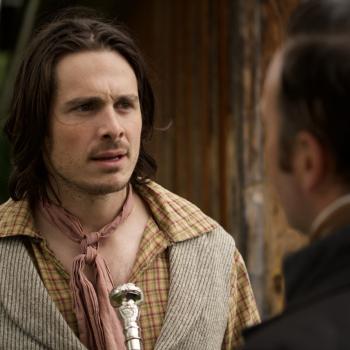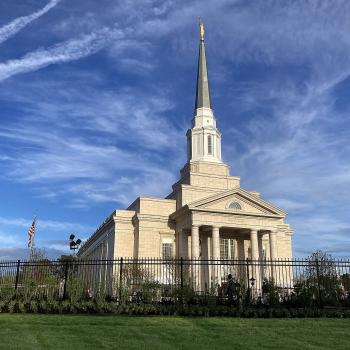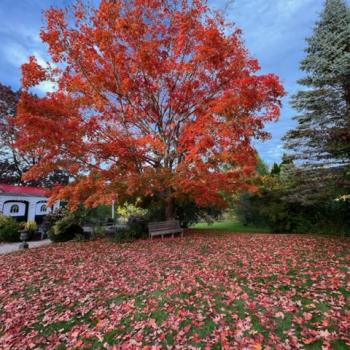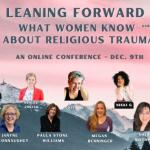
In a week during which we’ve been encouraged to #GiveThanks by the man whom I sustain as God’s chosen prophet, seer, and revelator in this time, I choose, today, to give thanks for certain of the Latter-day Saint scholars who influenced me at pivotal points in my life. These entries all need to be expanded, but here’s a start on what needs to be said:
The first of them that I’ll name is Truman G. Madsen (1926-2009).
In roughly 1968, an older couple in the ward in which I grew up — Ted and Alice Simmons, if I’m not mistaken, who were probably much younger then than I am now — mentioned something to me called BYU Education Week. It was coming up soon, they said, and was to be held in either Covina or West Covina. I can’t remember which, but in either case not far away. They thought that I would enjoy it and they offered to take me. (I was too young to drive at the time.) I will be forever grateful to them for that invitation. Attending Education Week on that occasion permanently changed my life. My parents weren’t academically inclined, my father wasn’t even yet a member of the Church of Jesus Christ of Latter-day Saints, and my mother was at most semi-active. It would never have occurred to me to attend.
Truman Madsen was one of the speakers there, for all four days. I had never heard of him. But his topics intrigued me. For a popular, non-specialist audience, he spoke about Marxism, logical positivism, and existentialism. Each day was a different topic. (I can’t remember the fourth lecture topic. Possibly pragmatism. He had a strong interest, as I now do for my own reasons, in William James, and he had earned his Ph.D. from the philosophy department at Harvard, where James had famously taught a few generations before.) I found him a riveting lecturer. I bought his wonderful little book Eternal Man and his pamphlet on “Joseph Smith among the Prophets,” and I devoured them.
In after years, he and his wife became friends — among other things, Ann and I served together for years on the Church’s Gospel Doctrine writing committee, and Truman was the director of BYU’s Jerusalem Center while I was leading an intensive Arabic program there — and his passing deeply saddened me.
Also speaking at that particular Education Week was Hugh Nibley (1910-2005).
In his case, I don’t actually recall what he spoke about that week. But I was absolutely smitten. Thereafter, while I was still living in southern California, whenever I heard that he was speaking somewhere in the greater Los Angeles area I made every effort to go hear him. He opened my eyes to a field of study — essentially, of the premodern eastern Mediterranean, the classical world, and the Near East — of which I had never thought. And here I am. In one sense, indeed, I’m somewhere between Hugh Nibley and Truman Madsen: My doctoral dissertation was on the Neoplatonic doctrine of God in an eleventh-century Arabic Shi‘ite Muslim philosopher. Even before that, though, hearing Truman Madsen and Hugh Nibley that year was the first thing that made me think about someday studying at Brigham Young University. And that has made all the difference.
Thereafter, Hugh also became a friend and a much senior and revered colleague. And, when he died, I felt forlorn.
I cannot fail to mention Richard Lloyd Anderson (1926-2018).
His book Investigating the Witnesses of the Book of Mormon may have had as much influence on me as any other book I’ve ever read. In fact, that book and his other invaluable writings on the topic continue to influence me powerfully still today: For one thing, without it there would simply be no Interpreter Foundation film project on the Witnesses.
His simple faith and his meticulous attention to detail continue to inspire me. Moreover, Richard was among the most gentle and Christlike men I’ve known, and I counted him as a friend. I take deep satisfaction in the fact that our film crew and I were able to interview him for two days not long before his death. I would have been gravely upset had we missed the opportunity.
Arnold H. Green (1940-2019) also belongs on this list.
Although he was a scholar, and an accomplished one, Arnie’s pivotal influence on me wasn’t solely or even mainly academic in nature. He was a historian of the Middle East in the colonial and postcolonial period whereas I’m a medievalist with inclinations to go even further back into antiquity, and I believe that I had only one class from him. He was teaching at the American University in Cairo when I arrived for study there; for at least part of that time, he was the head of the Center for Arabic Study. He was also the president of the Cairo Branch of the Church and, for a long time, the branch actually met in the Greens’ home. He and his wife Lani and their kids became a model for what I came to regard as a wonderful Latter-day Saint family — bright, open and accepting, both good-humored and hilariously funny, mutually loving . . . I could go on, but I don’t want to embarrass them. Suffice it to say that we loved the Cairo Branch and the time that we spent in it. When I became ill with hepatitis just before my wife went into labor with our firstborn, Lani (a nurse) and our Relief Society president (Carol Naguib) were indispensable. The branch was indispensable. And much of that was due to Lani and Arnie Green. When I decided to leave Cairo for UCLA, it was not without important discussions with Arnie.
His passing, after a period of horribly bad health, was probably a great relief to him, but a terrible loss to his friends and family.
I’ll mention another crucial influence. This one is of my own generation: my late friend Bill Hamblin (1954-2019).
How it still shocks me to think of him as “late”!
We met in Egypt in 1980. I was a graduate student there, in Middle Eastern history. He was a graduate student at the University of Michigan, and he came over for a year at the Center for Arabic Study Abroad. We bonded almost immediately over our shared passion for the kind of study pioneered by Hugh Nibley. Many years later, after I myself had joined the Department of Asian and Near Eastern Languages at Brigham Young University and he was teaching (not entirely happily) at the University of Southern Mississippi after a stint at the Department of Defense, I was able to help him land a position in the BYU History Department. It was one of my few academic political schemes ever actually to turn out for me.
For years, Bill and I worked together at BYU and in the old Foundation for Ancient Research and Mormon Studies, or FARMS, which then became the Institute for the Study and Preservation of Ancient Religious Texts and, eventually, the Neal A. Maxwell Institute for Religious Scholarship. We wrote articles together. We wrote a column for the Provo Daily Herald (his idea), and then, after an unpleasant and utterly weird experience there, eventually relaunched that column with the Deseret News.
His global breadth of vision never ceased to amaze me, like the freshness of his insights and the fertility of his mind. He was always interesting, and he could be very, very funny.
Bill’s sudden and quite unexpected death almost a year ago stunned me. It continues to feel unreal. (I published this column about him on 2 January 2020.)
I’ve gone on long enough. I’ve been playing it safe by sticking with influential friends who have passed beyond the veil. Let me, though, venture some very brief thoughts about three similarly influential friends who remain:
Incredibly, Jack Welch has been a friend and colleague for most of my life now. By launching the Foundation for Ancient Research and Mormon Studies (FARMS), he created an organization and a cause to which I would eventually devote a substantial part of my life for nearly a quarter of a century and which, when I was ultimately expelled from it (after Jack had himself been carefully and methodically eased out), inspired the creation of the Interpreter Foundation. More than that, though, his own unbelievably prolific output of brilliant scholarship has had a profound impact on me.
S. Kent Brown was the leader of the Jerusalem study abroad group in which I participated during the first half of 1978. It was my first time in the Near East. I had already graduated from BYU and had not yet been admitted to graduate school — whereby hangs a tale of its own — so I went with him to Jerusalem. He worked out some private tutoring with me, since I was the oldest, most “advanced” student in the group. By the time I had gone back to the United States to marry my fiancé and then come with her to Egypt, he and his wife were living in Cairo, where he met us at the airport. (That was unexpected and life-saving.) The Browns put us up in their apartment for several weeks while we looked for housing. Later, he put the chain of events in motion that resulted in my hiring at BYU (another tale to be told). He has been a colleague and a friend ever since.
Trained in archaeology and anthropology, which he taught for years at Brigham Young University, John L. Sorenson was also involved in the founding of FARMS. I recall reading his 1984 book, An Ancient American Setting for the Book of Mormon, when it first appeared. I wrote in my journal that it was the best thing that I had ever read on the geography of the Book of Mormon. Then I corrected myself: It was, I wrote, the first serious thing that I had ever read on the subject. A game-changer. To me, he has been for the Book of Mormon and the New World what Hugh Nibley was for the Book of Mormon and the Old. Closing in on his ninety-seventh birthday, he has finally withdrawn from public engagement on such issues, and no longer even participates in the meetings of our monthly reading group.
My debt to these and many other people is enormous. I can never pay it back.
***
In response to deafening popular demand — it must have been deafening, because I didn’t hear any — here are links to some of the Thanksgiving columns that I’ve written for the Deseret News in previous years. I’ve already shared three of them. It’s possible that you might find something in one or two of them that might be helpful to you or someone you know:
2011: “Gratitude to our God is paramount”
2012: “We owe a debt to God, our predecessors”
2013: “Thanksgiving is for reflection, not just eating”
2013 (with William J. Hamblin): “Thanksgiving has very ancient roots”
2014: “A day for grateful reflection”
2015: “Reasons for gratitude on this Thanksgiving Day”
2016: “We have more cause for thanksgiving than any previous generation”
2017: “The miracle of Thanksgiving pies”
***
“Church leaders respond to President Nelson’s invitation to #GiveThanks”
***
It’s not a cure, of course. But what if, by engaging in a simple practice that has no serious downsides (beyond icky taste) while offering several other substantial and demonstrable benefits, you could reduce your risk of contracting COVID-19? Even if it were only by, say, even 10% or 5% or 1%? Why not do it?
“New Study Suggests Mouthwash Can Kill Coronavirus in Saliva in 30 Seconds”
***
***
I occasionally look in on The Volokh Conspiracy, a legally oriented blog led by Eugene Volokh, a brilliant professor of law at the University of California at Los Angeles (UCLA), that leans libertarian/conservative. Here’s a recent entry from the blog:
Group Statement on the 2020 Election
“A statement signed by multiple VC contributors calling on Donald Trump and the Republican Party to accept the election result and stop promoting unsubstantiated accusations of fraud.”
***
With this important precedent in mind, I’m thoroughly revising my retirement plans. For one thing, I’ve taken to making coffins in my backyard:
“Man Becomes A Millionaire When Meteorite From Heaven Crashes Through His Roof”
***
Finally, here is an important statement that I was very pleased to sign. I encourage you to read it through:
“Latter-day Saint Radical Orthodoxy: A Manifesto”












